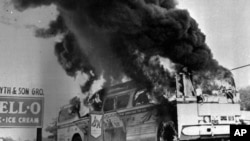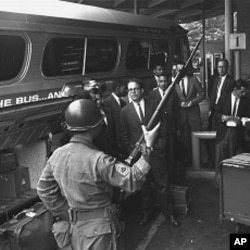The American South was a segregated society 50 years ago. In 1960, the U.S. Supreme Court outlawed racial segregation in restaurants and bus terminals serving interstate travel, but African-Americans who tried to sit in the "whites only" section risked injury or even death at the hands of white mobs. In May of 1961, groups of black and white civil rights activists set out together to change all that.
They called themselves "Freedom Riders." An integrated group of young civil rights activists decided to confront the racist practices in the Deep South, by travelling together by bus from Washington D.C. to New Orleans, Louisiana. Raymond Arsenault documents their trip in "Freedom Riders: 1961 and the Struggle for Racial Justice." He says many elder civil rights leaders denounced their strategy as a dangerous provocation that would set back the cause.
"But the members of the Congress of Racial Equality that came up with this idea, the young activists, were absolutely determined that they were going to force the issue, that they had to fight for 'freedom now,' not 'freedom later,' [and] that someone had to take the struggle out of the courtroom and into the streets, even if it meant for death for some of them. They were willing to die to make this point," said Arsenault.
Watch related Deborah Block video report
The group boarded a Greyhound bus in Washington on May 4. They planned to stop and organize others along the way until they reached their destination on May 17. Like Martin Luther King, Jr. and other prominent civil rights activists of the day, the Freedom Riders were trained in the techniques of non-violent direct action developed by the Indian leader Mahatma Gandhi. Arsenault says that for some of them, non-violence was a deeply held philosophy. For others, it was a tactic to win public support for their struggle.
"Part of what they did was they dressed very well, almost like they were going to church and they were absolutely committed to not striking back and being polite, and to contrast their behavior with what they saw as the white thugs who might very well attack them, and of course did," added Arsenault.
The Freedom Riders were taunted - and attacked - throughout the South. John Lewis, now a U.S. Congressman, was badly beaten in South Carolina. Worse trouble awaited the Freedom Riders in Birmingham, Alabama, where white supremacists beat the Riders with clubs and chains while police looked on. In Anniston, Alabama, a mob surrounded the bus, slashed its tires, and firebombed it on a lone stretch of highway outside of town.
In interviews culled from "Freedom Riders", a new PBS documentary tied to Arsenault's book, several of the Riders recall how they narrowly escaped death.
"I can't tell you if I walked off if I walked off the bus or crawled off, or someone pulled me off," said one woman.
"When I got off the bus, a man came up to me, and I am coughing and strangling and he said 'Boy, are you alright?' And I nodded, and the next thing I knew I was on the ground. He had hit me with a baseball bat," said one man.
"People were gagging and they were crawling around the ground and they were trying to get the smoke out of their chests It was just an awful, awful, awful, awful scene," said another Rider.
"It was horrible. It was like a scene from Hell. The worst suffering I had ever heard," one woman said.
The Freedom Riders, many of them injured, chose to fly the rest of their journey to New Orleans. However, activists in Nashville, Tennessee, immediately organized their own Freedom Ride through Alabama and Mississippi. They felt that failing to continue the effort would hand a victory to the segregationists who wanted to intimidate them.
Like many of her fellow Nashville Freedom Riders, Catherine Burk-Brooks, a black college student, decided to leave school to make the trip.
"This was more important at that time to a number of us at that time in Nashville," said Burk-Brooks. "We knew that if we lived we would go back to school, and if we died, it wouldn't make any difference. We didn't know if we were going to live or die. But we knew that this was something that we had to do."
The Kennedy administration feared that more violence would embarrass the president at a Cold War summit with Soviet Premier Khrushchev later that month. A deal was struck with the Mississippi authorities. Police officers would protect the Riders from attack, but would be empowered to arrest them for violating state laws.
Joan Mulholland, a white Freedom Rider who was 19 at the time, was thrown into the State Penitentiary, along with other activists.
"So we were charged with breach of peace which was not on the face of it a segregation law, but was used to enforce segregation by saying that our very presence and actions could cause other people to become violent," Mulholland said. "So we were charged with breaking the peace by upsetting people."
Such treatment galvanized the national civil rights movement. During the spring and summer of 1961, 60 Freedom Rides headed south from around the country, forcing the issue of segregation into national focus.
The momentum of the civil rights movement increased through sit-ins, voter registration drives, legal advocacy and demonstrations. It led to stronger anti-discrimination laws and their enforcement.
Raymond Arsenault says the Riders are an inspiring example to those who want to change the world, today.
"All of us, wherever we live in the world, have moments when we shrug our shoulders and say 'what can I do? What can we do?' We're overwhelmed by these powerful socio-economic forces that seem to control our lives," added Aresenault. "I think the Freedom Rides are a classic example that demonstrates the power of individuals to change the course of history. It's not just so-called 'people in power' who are controlling institutions. There is a lot of historical agency that people can grasp. The Freedom Rides reminds us there are people who have stepped up and changed all of our lives and that we can do that too."
Fiftieth anniversary commemorations of the 1961 Freedom Rides will be held throughout the spring and summer, including the 2011 Student Freedom Ride, in which young people, black and white, will board buses in Washington, D.C., to follow the path of that first ride, spreading the message of civil rights.











